2007 ISUZU KB P190 sensor
[x] Cancel search: sensorPage 1073 of 6020
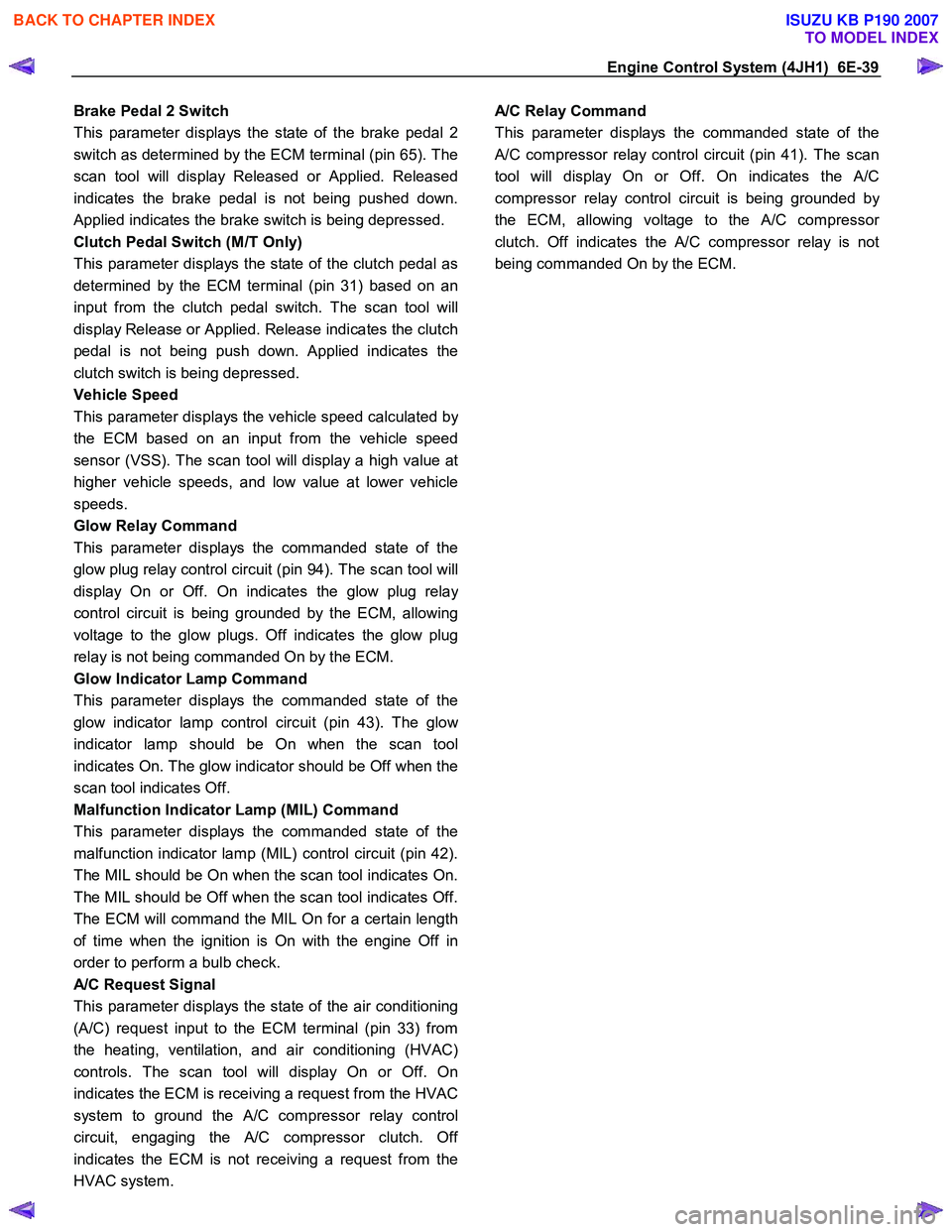
Engine Control System (4JH1) 6E-39
Brake Pedal 2 Switch
This parameter displays the state of the brake pedal 2
switch as determined by the ECM terminal (pin 65). The
scan tool will display Released or Applied. Released
indicates the brake pedal is not being pushed down.
Applied indicates the brake switch is being depressed.
Clutch Pedal Switch (M/T Only)
This parameter displays the state of the clutch pedal as
determined by the ECM terminal (pin 31) based on an
input from the clutch pedal switch. The scan tool will
display Release or Applied. Release indicates the clutch
pedal is not being push down. Applied indicates the
clutch switch is being depressed.
Vehicle Speed
This parameter displays the vehicle speed calculated b
y
the ECM based on an input from the vehicle speed
sensor (VSS). The scan tool will display a high value at
higher vehicle speeds, and low value at lower vehicle
speeds.
Glow Relay Command
This parameter displays the commanded state of the
glow plug relay control circuit (pin 94). The scan tool will
display On or Off. On indicates the glow plug rela
y
control circuit is being grounded by the ECM, allowing
voltage to the glow plugs. Off indicates the glow plug
relay is not being commanded On by the ECM.
Glow Indicator Lamp Command
This parameter displays the commanded state of the
glow indicator lamp control circuit (pin 43). The glo
w
indicator lamp should be On when the scan tool
indicates On. The glow indicator should be Off when the
scan tool indicates Off.
Malfunction Indicator Lamp (MIL) Command
This parameter displays the commanded state of the
malfunction indicator lamp (MIL) control circuit (pin 42).
The MIL should be On when the scan tool indicates On.
The MIL should be Off when the scan tool indicates Off.
The ECM will command the MIL On for a certain length
of time when the ignition is On with the engine Off in
order to perform a bulb check.
A/C Request Signal
This parameter displays the state of the air conditioning
(A/C) request input to the ECM terminal (pin 33) from
the heating, ventilation, and air conditioning (HVAC)
controls. The scan tool will display On or Off. On
indicates the ECM is receiving a request from the HVAC
system to ground the A/C compressor relay control
circuit, engaging the
A/C compressor clutch. Off
indicates the ECM is not receiving a request from the
HVAC system.
A/C Relay Command
This parameter displays the commanded state of the
A/C compressor relay control circuit (pin 41). The scan
tool will display On or Off. On indicates the
A/C
compressor relay control circuit is being grounded b
y
the ECM, allowing voltage to the A/C compressor
clutch. Off indicates the A/C compressor relay is not
being commanded On by the ECM.
BACK TO CHAPTER INDEX
TO MODEL INDEX
ISUZU KB P190 2007
Page 1074 of 6020
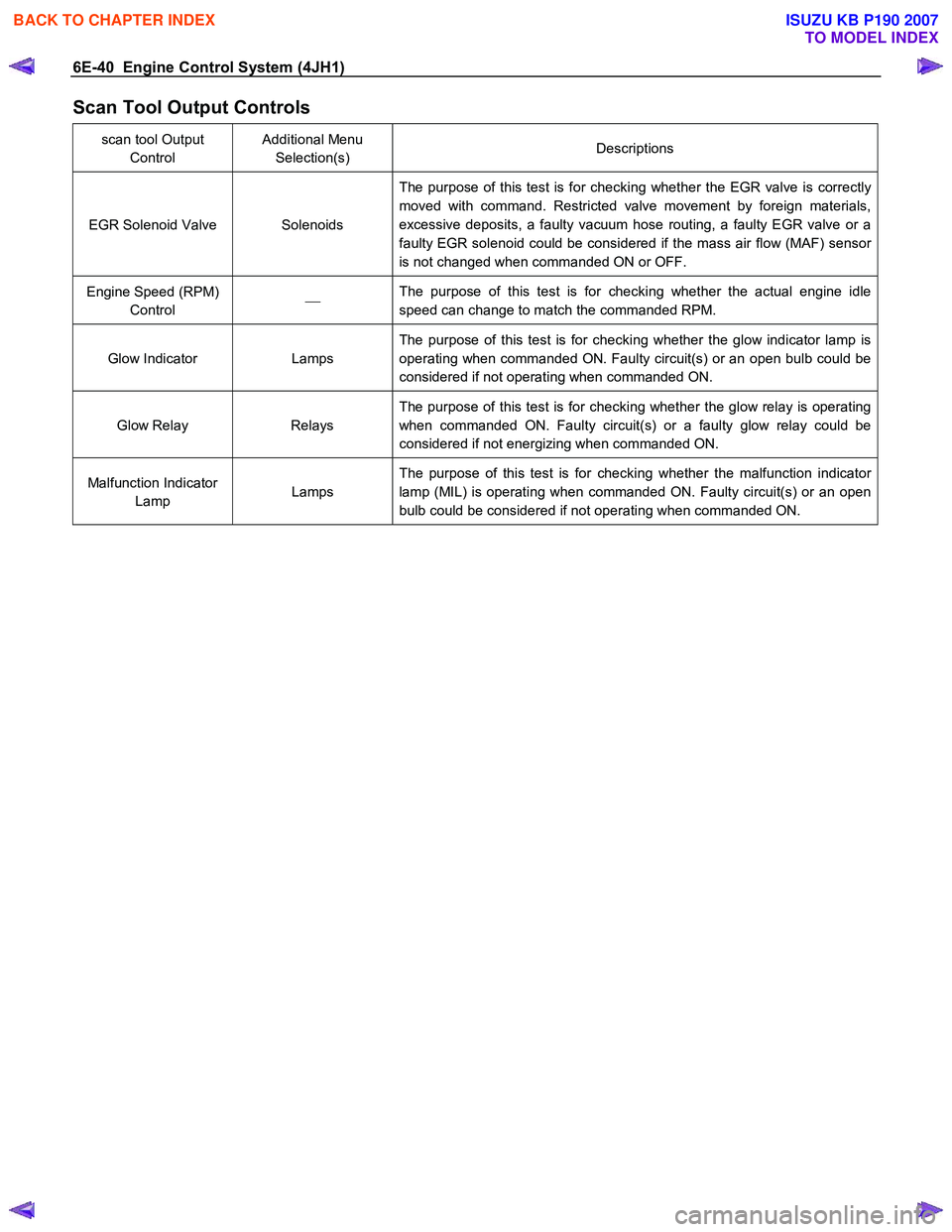
6E-40 Engine Control System (4JH1)
Scan Tool Output Controls
scan tool Output Control Additional Menu
Selection(s) Descriptions
EGR Solenoid Valve Solenoids The purpose of this test is for checking whether the EGR valve is correctly
moved with command. Restricted valve movement by foreign materials,
excessive deposits, a faulty vacuum hose routing, a faulty EGR valve or a
faulty EGR solenoid could be considered if the mass air flow (MAF) sensor
is not changed when commanded ON or OFF.
Engine Speed (RPM) Control
The purpose of this test is for checking whether the actual engine idle
speed can change to match the commanded RPM.
Glow Indicator Lamps The purpose of this test is for checking whether the glow indicator lamp is
operating when commanded ON. Faulty circuit(s) or an open bulb could be
considered if not operating when commanded ON.
Glow Relay Relays The purpose of this test is for checking whether the glow relay is operating
when commanded ON. Faulty circuit(s) or a faulty glow relay could be
considered if not energizing when commanded ON.
Malfunction Indicator Lamp Lamps The purpose of this test is for checking whether the malfunction indicator
lamp (MIL) is operating when commanded ON. Faulty circuit(s) or an open
bulb could be considered if not operating when commanded ON.
BACK TO CHAPTER INDEX
TO MODEL INDEX
ISUZU KB P190 2007
Page 1081 of 6020
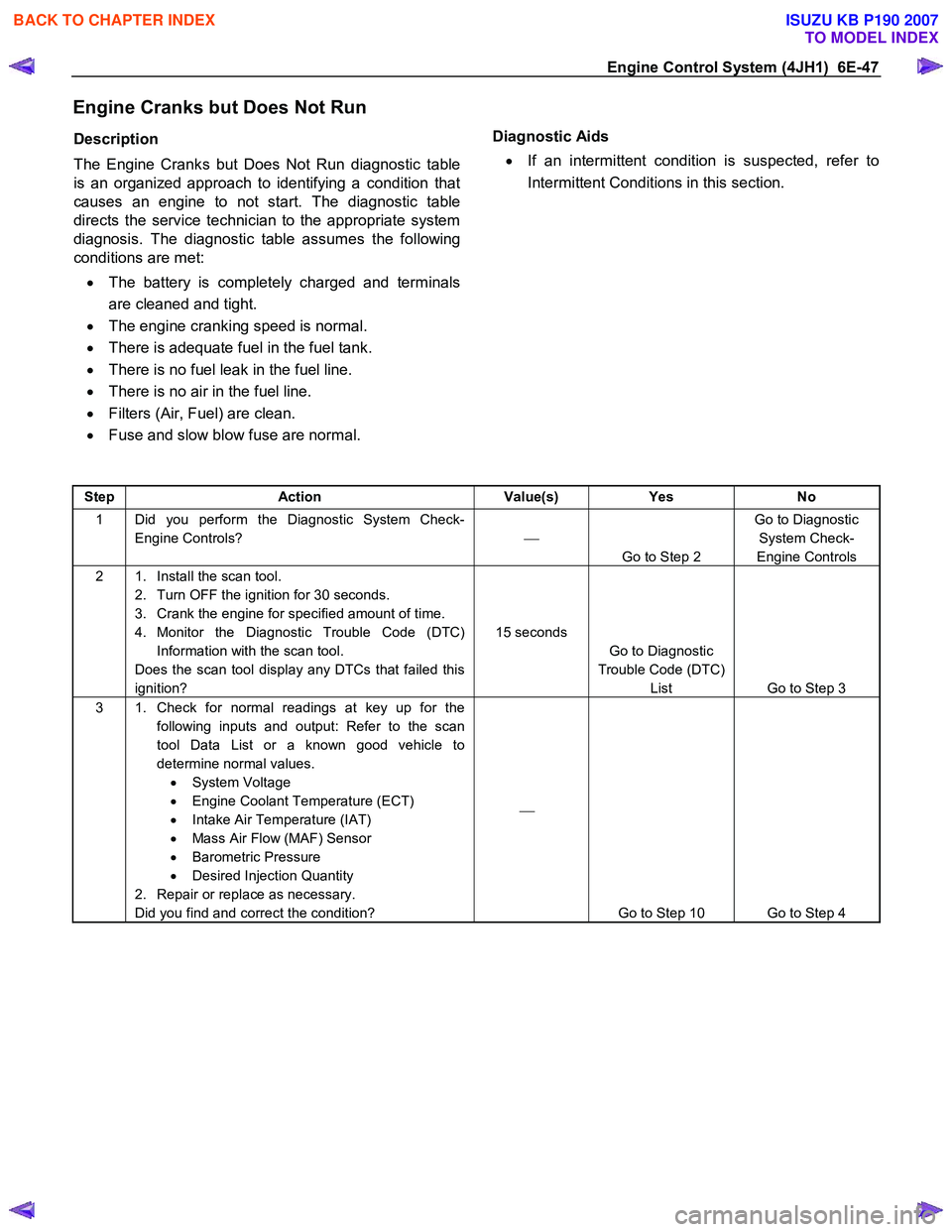
Engine Control System (4JH1) 6E-47
Engine Cranks but Does Not Run
Description
The Engine Cranks but Does Not Run diagnostic table
is an organized approach to identifying a condition that
causes an engine to not start. The diagnostic table
directs the service technician to the appropriate system
diagnosis. The diagnostic table assumes the following
conditions are met:
• The battery is completely charged and terminals
are cleaned and tight.
• The engine cranking speed is normal.
• There is adequate fuel in the fuel tank.
• There is no fuel leak in the fuel line.
• There is no air in the fuel line.
• Filters (Air, Fuel) are clean.
• Fuse and slow blow fuse are normal.
Diagnostic Aids
• If an intermittent condition is suspected, refer to
Intermittent Conditions in this section.
Step Action Value(s) Yes No
1 Did you perform the Diagnostic System Check-
Engine Controls?
Go to Step 2 Go to Diagnostic
System Check-
Engine Controls
2 1. Install the scan tool. 2. Turn OFF the ignition for 30 seconds.
3. Crank the engine for specified amount of time.
4. Monitor the Diagnostic Trouble Code (DTC) Information with the scan tool.
Does the scan tool display any DTCs that failed this
ignition? 15 seconds
Go to Diagnostic
Trouble Code (DTC) List Go to Step 3
3 1. Check for normal readings at key up for the
following inputs and output: Refer to the scan
tool Data List or a known good vehicle to
determine normal values. • System Voltage
• Engine Coolant Temperature (ECT)
• Intake Air Temperature (IAT)
• Mass Air Flow (MAF) Sensor
• Barometric Pressure
• Desired Injection Quantity
2. Repair or replace as necessary.
Did you find and correct the condition?
Go to Step 10 Go to Step 4
BACK TO CHAPTER INDEX
TO MODEL INDEX
ISUZU KB P190 2007
Page 1083 of 6020
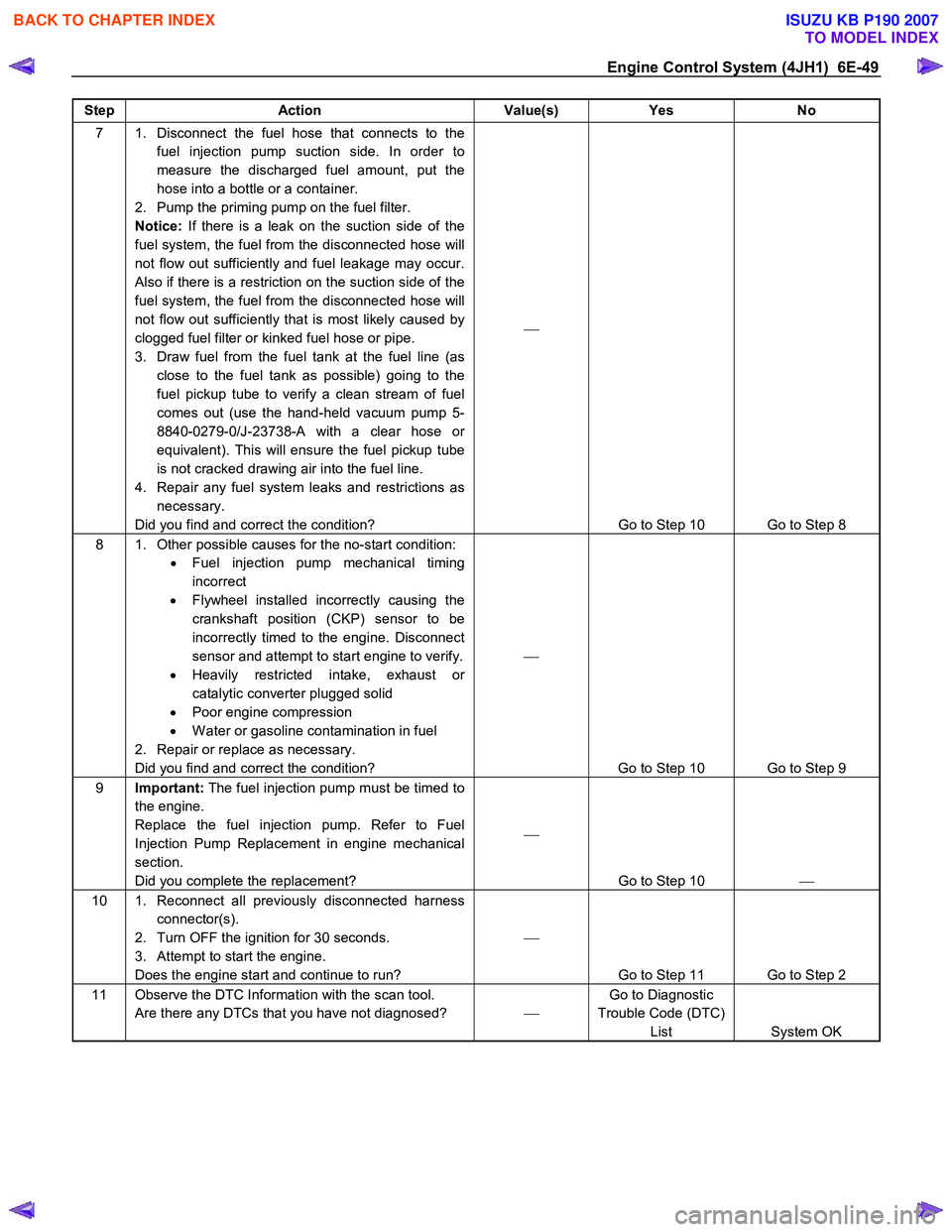
Engine Control System (4JH1) 6E-49
Step Action Value(s) Yes No
7 1. Disconnect the fuel hose that connects to the
fuel injection pump suction side. In order to
measure the discharged fuel amount, put the
hose into a bottle or a container.
2. Pump the priming pump on the fuel filter.
Notice: If there is a leak on the suction side of the
fuel system, the fuel from the disconnected hose will
not flow out sufficiently and fuel leakage may occur.
Also if there is a restriction on the suction side of the
fuel system, the fuel from the disconnected hose will
not flow out sufficiently that is most likely caused by
clogged fuel filter or kinked fuel hose or pipe.
3. Draw fuel from the fuel tank at the fuel line (as close to the fuel tank as possible) going to the
fuel pickup tube to verify a clean stream of fuel
comes out (use the hand-held vacuum pump 5-
8840-0279-0/J-23738-A with a clear hose or
equivalent). This will ensure the fuel pickup tube
is not cracked drawing air into the fuel line.
4. Repair any fuel system leaks and restrictions as necessary.
Did you find and correct the condition?
Go to Step 10 Go to Step 8
8 1. Other possible causes for the no-start condition: • Fuel injection pump mechanical timing
incorrect
• Flywheel installed incorrectly causing the
crankshaft position (CKP) sensor to be
incorrectly timed to the engine. Disconnect
sensor and attempt to start engine to verify.
• Heavily restricted intake, exhaust or
catalytic converter plugged solid
• Poor engine compression
• W ater or gasoline contamination in fuel
2. Repair or replace as necessary.
Did you find and correct the condition?
Go to Step 10 Go to Step 9
9 Important: The fuel injection pump must be timed to
the engine.
Replace the fuel injection pump. Refer to Fuel
Injection Pump Replacement in engine mechanical
section.
Did you complete the replacement?
Go to Step 10
10 1. Reconnect all previously disconnected harness
connector(s).
2. Turn OFF the ignition for 30 seconds.
3. Attempt to start the engine.
Does the engine start and continue to run?
Go to Step 11 Go to Step 2
11 Observe the DTC Information with the scan tool. Are there any DTCs that you have not diagnosed? Go to Diagnostic
Trouble Code (DTC) List System OK
BACK TO CHAPTER INDEX
TO MODEL INDEX
ISUZU KB P190 2007
Page 1084 of 6020

6E-50 Engine Control System (4JH1)
Diagnostic Trouble Code (DTC) List
DTC
(Symptom Code) Flash
Code MIL
Status DTC Name on
scan tool Condition for
Running the DTC Condition for
Setting the DTC Possible Cause
P0100
(7) 65 ON Mass Air Flow
(MAF) Sensor
Circuit 5V
Reference High
Voltage •
The ignition switch
is ON.
•
The ECM detects
that the MAF sensor
5 volts reference
circuit voltage is
more than 5.2 volts
for 0.5 seconds. •
Sensor 5V reference circuit is
short to battery or ignition
voltage.
• Sensor 5V reference circuit is
short to the sensor ignition
voltage circuit.
• Faulty MAF sensor.
• Faulty ECM.
P0100 (9) 65 ON Mass Air Flow
(MAF) Sensor
Voltage 5V
Reference Circuit
Low Voltage •
The ignition switch
is ON.
•
The ECM detects
that the MAF sensor
5 volts reference
circuit voltage is
less than 4.6 volts
for 0.5 seconds. •
Sensor 5V reference circuit is
short to ground.
• Sensor 5V reference circuit is
short to the low reference circuit.
• Faulty MAF sensor.
• Faulty ECM.
P0100 (B) 65 ON Mass Air Flow
(MAF) Sensor
Circuit Low
Voltage •
The ignition switch
is ON.
• The engine is
running.
•
The ECM calculated
MAF is lower than -
18.6 kg/h for 5
seconds.
•
ECM (10A) fuse (EB1) open.
• Sensor ignition voltage feed
circuit is open circuit or high
resistance.
• Sensor 5V reference circuit is
open circuit, high resistance,
short to ground or short to the
low reference circuit.
• Sensor signal circuit is open
circuit, high resistance, short to
ground or short to the low
reference circuit.
• Poor harness connector
connection.
• Faulty MAF sensor installation.
• Faulty MAF sensor.
• Faulty ECM.
P0100 (C) 65 ON Mass Air Flow
(MAF) Sensor
Circuit High
Voltage •
The ignition switch
is ON.
• The engine is
running.
•
The ECM calculated
MAF is higher than
984 kg/h for 10
seconds.
•
Sensor signal circuit is short to
any 5V reference circuit, short to
battery or ignition voltage circuit.
• Sensor low reference circuit is
open circuit or high resistance.
• Poor harness connector
connection.
• Faulty MAF sensor.
• Faulty ECM.
P0105 (1) 34 ON Vacuum Pressure
Sensor Circuit
High Voltage •
The ignition switch
is ON. •
The ECM detects
that the vacuum
pressure sensor
signal voltage is
more than 4.4 volts
for 3 seconds. •
Sensor 5V reference circuit is
short to battery or ignition
voltage.
• Sensor signal circuit is short to
any 5V reference circuit, short to
battery or ignition voltage.
• Sensor low reference circuit is
open circuit or high resistance.
• Poor harness connector
connection.
• Faulty vacuum pressure sensor.
• Faulty ECM.
BACK TO CHAPTER INDEX
TO MODEL INDEX
ISUZU KB P190 2007
Page 1085 of 6020
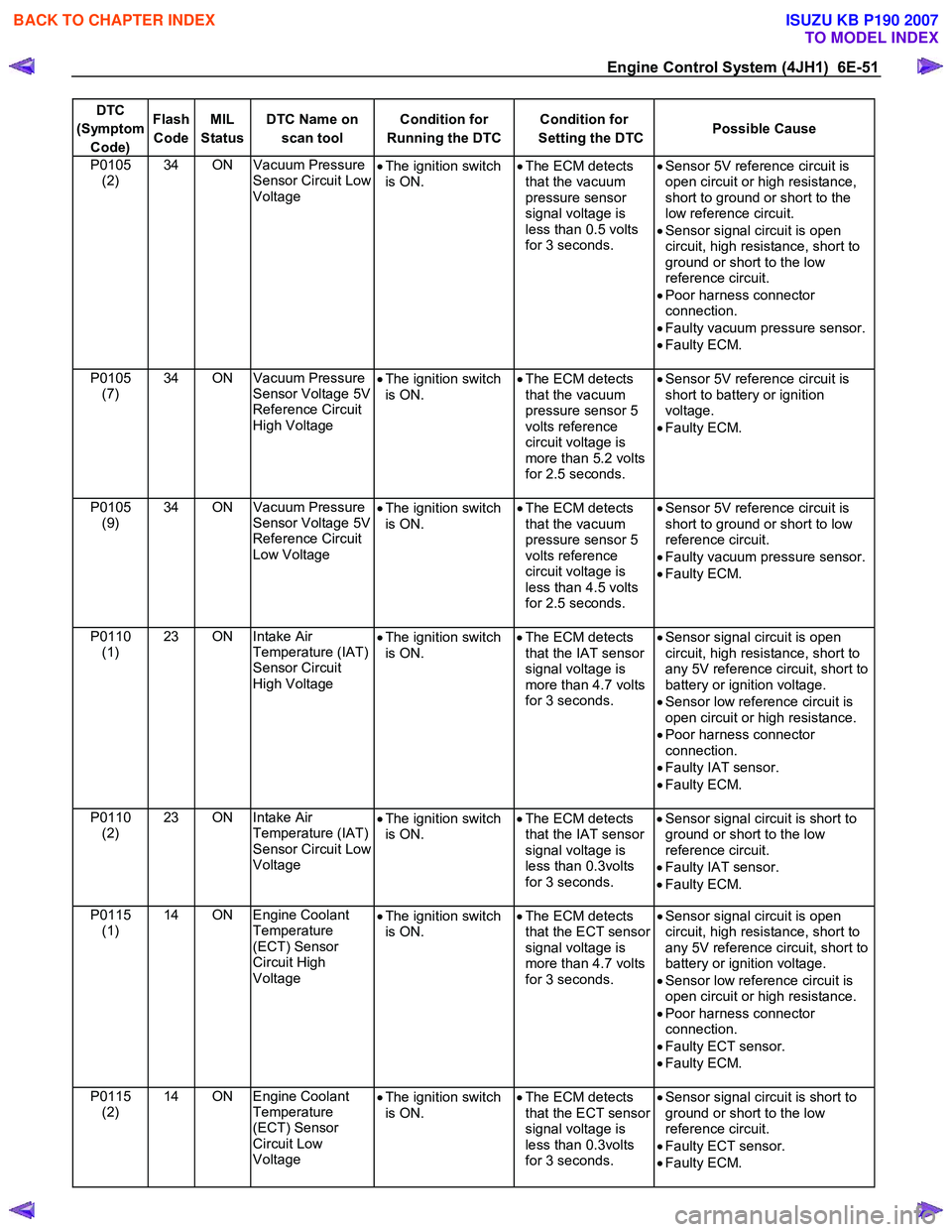
Engine Control System (4JH1) 6E-51
DTC
(Symptom Code) Flash
Code MIL
Status DTC Name on
scan tool Condition for
Running the DTC Condition for
Setting the DTC Possible Cause
P0105
(2) 34 ON Vacuum Pressure
Sensor Circuit Low
Voltage •
The ignition switch
is ON. •
The ECM detects
that the vacuum
pressure sensor
signal voltage is
less than 0.5 volts
for 3 seconds. •
Sensor 5V reference circuit is
open circuit or high resistance,
short to ground or short to the
low reference circuit.
• Sensor signal circuit is open
circuit, high resistance, short to
ground or short to the low
reference circuit.
• Poor harness connector
connection.
• Faulty vacuum pressure sensor.
• Faulty ECM.
P0105 (7) 34 ON Vacuum Pressure
Sensor Voltage 5V
Reference Circuit
High Voltage
•
The ignition switch
is ON. •
The ECM detects
that the vacuum
pressure sensor 5
volts reference
circuit voltage is
more than 5.2 volts
for 2.5 seconds.
•
Sensor 5V reference circuit is
short to battery or ignition
voltage.
• Faulty ECM.
P0105 (9) 34 ON Vacuum Pressure
Sensor Voltage 5V
Reference Circuit
Low Voltage
•
The ignition switch
is ON. •
The ECM detects
that the vacuum
pressure sensor 5
volts reference
circuit voltage is
less than 4.5 volts
for 2.5 seconds.
•
Sensor 5V reference circuit is
short to ground or short to low
reference circuit.
• Faulty vacuum pressure sensor.
• Faulty ECM.
P0110 (1) 23 ON Intake Air
Temperature (IAT)
Sensor Circuit
High Voltage •
The ignition switch
is ON.
•
The ECM detects
that the IAT sensor
signal voltage is
more than 4.7 volts
for 3 seconds. •
Sensor signal circuit is open
circuit, high resistance, short to
any 5V reference circuit, short to
battery or ignition voltage.
• Sensor low reference circuit is
open circuit or high resistance.
• Poor harness connector
connection.
• Faulty IAT sensor.
• Faulty ECM.
P0110 (2) 23 ON Intake Air
Temperature (IAT)
Sensor Circuit Low
Voltage
•
The ignition switch
is ON.
•
The ECM detects
that the IAT sensor
signal voltage is
less than 0.3volts
for 3 seconds.
•
Sensor signal circuit is short to
ground or short to the low
reference circuit.
• Faulty IAT sensor.
• Faulty ECM.
P0115
(1) 14 ON Engine Coolant
Temperature
(ECT) Sensor
Circuit High
Voltage •
The ignition switch
is ON.
•
The ECM detects
that the ECT sensor
signal voltage is
more than 4.7 volts
for 3 seconds. •
Sensor signal circuit is open
circuit, high resistance, short to
any 5V reference circuit, short to
battery or ignition voltage.
• Sensor low reference circuit is
open circuit or high resistance.
• Poor harness connector
connection.
• Faulty ECT sensor.
• Faulty ECM.
P0115 (2) 14 ON Engine Coolant
Temperature
(ECT) Sensor
Circuit Low
Voltage
•
The ignition switch
is ON.
•
The ECM detects
that the ECT sensor
signal voltage is
less than 0.3volts
for 3 seconds. •
Sensor signal circuit is short to
ground or short to the low
reference circuit.
• Faulty ECT sensor.
• Faulty ECM.
BACK TO CHAPTER INDEX
TO MODEL INDEX
ISUZU KB P190 2007
Page 1086 of 6020
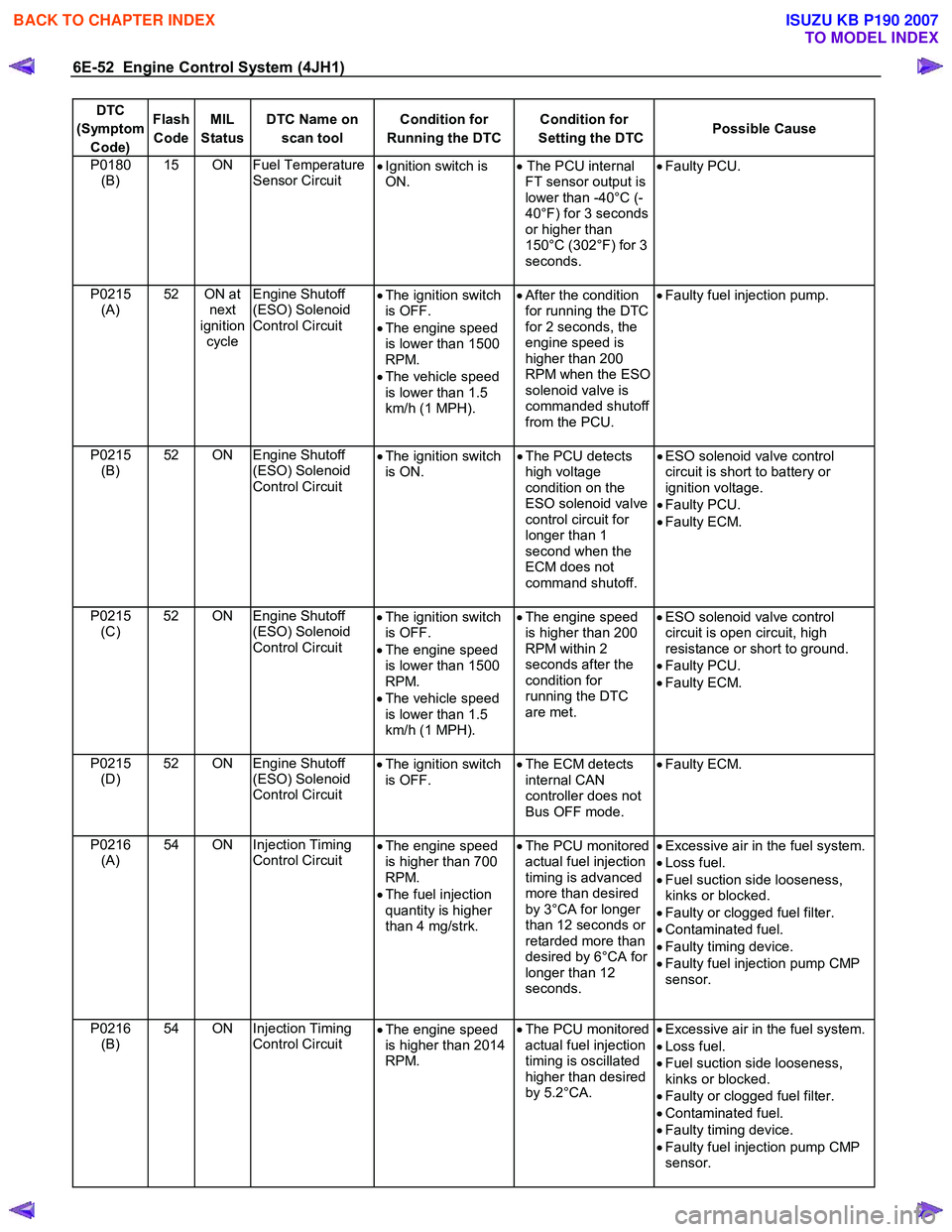
6E-52 Engine Control System (4JH1)
DTC
(Symptom Code) Flash
Code MIL
Status DTC Name on
scan tool Condition for
Running the DTC Condition for
Setting the DTC Possible Cause
P0180
(B) 15 ON Fuel Temperature
Sensor Circuit •
Ignition switch is
ON.
•
The PCU internal
FT sensor output is
lower than -40°C (-
40°F) for 3 seconds
or higher than
150°C (302°F) for 3
seconds.
•
Faulty PCU.
P0215 (A) 52 ON at
next
ignition cycle Engine Shutoff
(ESO) Solenoid
Control Circuit •
The ignition switch
is OFF.
• The engine speed
is lower than 1500
RPM.
• The vehicle speed
is lower than 1.5
km/h (1 MPH).
•
After the condition
for running the DTC
for 2 seconds, the
engine speed is
higher than 200
RPM when the ESO
solenoid valve is
commanded shutoff
from the PCU.
•
Faulty fuel injection pump.
P0215 (B) 52 ON Engine Shutoff
(ESO) Solenoid
Control Circuit •
The ignition switch
is ON. •
The PCU detects
high voltage
condition on the
ESO solenoid valve
control circuit for
longer than 1
second when the
ECM does not
command shutoff.
•
ESO solenoid valve control
circuit is short to battery or
ignition voltage.
• Faulty PCU.
• Faulty ECM.
P0215 (C) 52 ON Engine Shutoff
(ESO) Solenoid
Control Circuit •
The ignition switch
is OFF.
• The engine speed
is lower than 1500
RPM.
• The vehicle speed
is lower than 1.5
km/h (1 MPH).
•
The engine speed
is higher than 200
RPM within 2
seconds after the
condition for
running the DTC
are met.
•
ESO solenoid valve control
circuit is open circuit, high
resistance or short to ground.
• Faulty PCU.
• Faulty ECM.
P0215 (D) 52 ON Engine Shutoff
(ESO) Solenoid
Control Circuit
•
The ignition switch
is OFF. •
The ECM detects
internal CAN
controller does not
Bus OFF mode.
•
Faulty ECM.
P0216 (A) 54 ON Injection Timing
Control Circuit •
The engine speed
is higher than 700
RPM.
• The fuel injection
quantity is higher
than 4 mg/strk.
•
The PCU monitored
actual fuel injection
timing is advanced
more than desired
by 3°CA for longer
than 12 seconds or
retarded more than
desired by 6°CA for
longer than 12
seconds.
•
Excessive air in the fuel system.
• Loss fuel.
• Fuel suction side looseness,
kinks or blocked.
• Faulty or clogged fuel filter.
• Contaminated fuel.
• Faulty timing device.
• Faulty fuel injection pump CMP
sensor.
P0216 (B) 54 ON Injection Timing
Control Circuit •
The engine speed
is higher than 2014
RPM.
•
The PCU monitored
actual fuel injection
timing is oscillated
higher than desired
by 5.2°CA.
•
Excessive air in the fuel system.
• Loss fuel.
• Fuel suction side looseness,
kinks or blocked.
• Faulty or clogged fuel filter.
• Contaminated fuel.
• Faulty timing device.
• Faulty fuel injection pump CMP
sensor.
BACK TO CHAPTER INDEX
TO MODEL INDEX
ISUZU KB P190 2007
Page 1087 of 6020
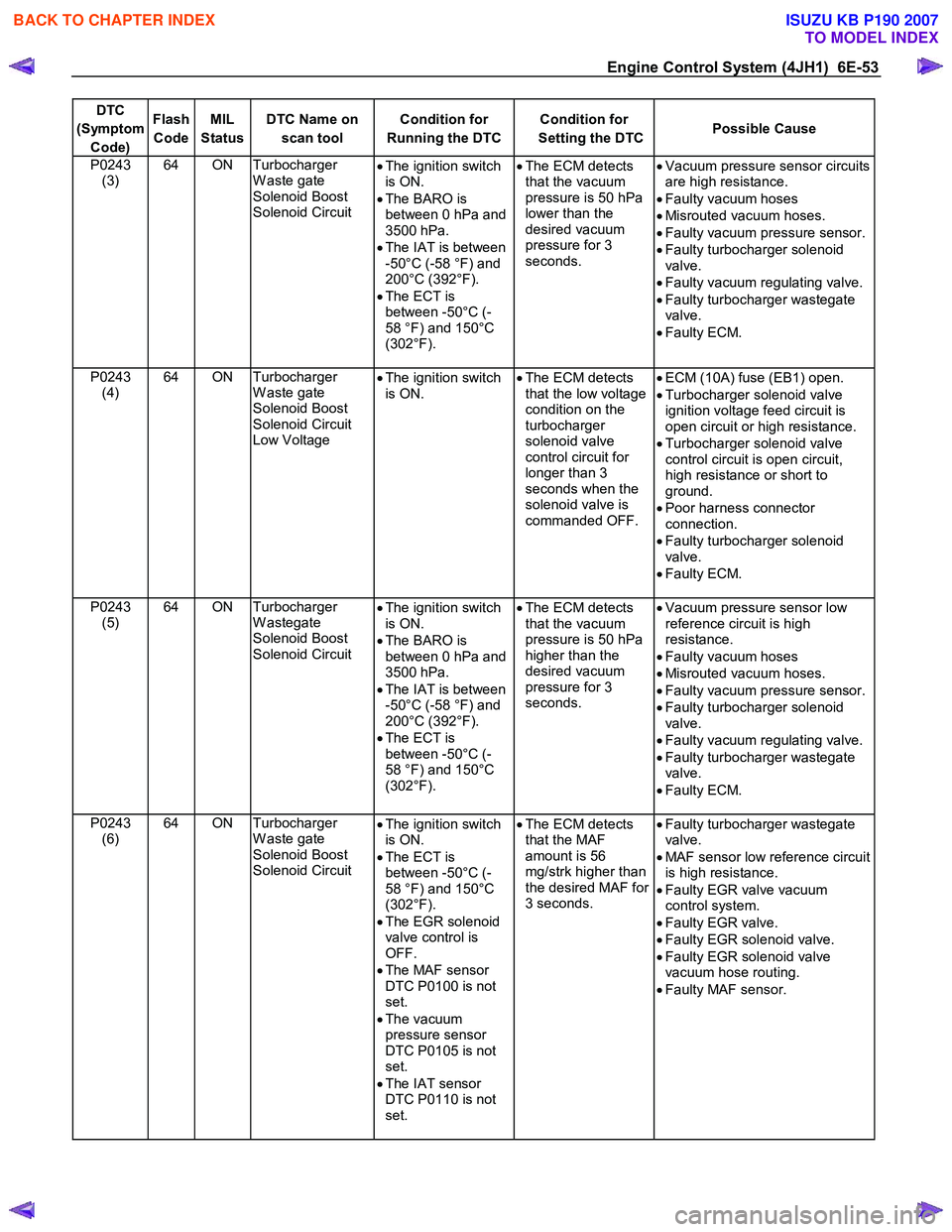
Engine Control System (4JH1) 6E-53
DTC
(Symptom Code) Flash
Code MIL
Status DTC Name on
scan tool Condition for
Running the DTC Condition for
Setting the DTC Possible Cause
P0243
(3) 64 ON Turbocharger
W aste gate
Solenoid Boost
Solenoid Circuit •
The ignition switch
is ON.
• The BARO is
between 0 hPa and
3500 hPa.
• The IAT is between
-50°C (-58 °F) and
200°C (392°F).
• The ECT is
between -50°C (-
58 °F) and 150°C
(302°F).
•
The ECM detects
that the vacuum
pressure is 50 hPa
lower than the
desired vacuum
pressure for 3
seconds.
•
Vacuum pressure sensor circuits
are high resistance.
• Faulty vacuum hoses
• Misrouted vacuum hoses.
• Faulty vacuum pressure sensor.
• Faulty turbocharger solenoid
valve.
• Faulty vacuum regulating valve.
• Faulty turbocharger wastegate
valve.
• Faulty ECM.
P0243 (4) 64 ON Turbocharger
W aste gate
Solenoid Boost
Solenoid Circuit
Low Voltage •
The ignition switch
is ON.
•
The ECM detects
that the low voltage
condition on the
turbocharger
solenoid valve
control circuit for
longer than 3
seconds when the
solenoid valve is
commanded OFF.
•
ECM (10A) fuse (EB1) open.
• Turbocharger solenoid valve
ignition voltage feed circuit is
open circuit or high resistance.
• Turbocharger solenoid valve
control circuit is open circuit,
high resistance or short to
ground.
• Poor harness connector
connection.
• Faulty turbocharger solenoid
valve.
• Faulty ECM.
P0243 (5) 64 ON Turbocharger
W astegate
Solenoid Boost
Solenoid Circuit •
The ignition switch
is ON.
• The BARO is
between 0 hPa and
3500 hPa.
• The IAT is between
-50°C (-58 °F) and
200°C (392°F).
• The ECT is
between -50°C (-
58 °F) and 150°C
(302°F).
•
The ECM detects
that the vacuum
pressure is 50 hPa
higher than the
desired vacuum
pressure for 3
seconds.
•
Vacuum pressure sensor low
reference circuit is high
resistance.
• Faulty vacuum hoses
• Misrouted vacuum hoses.
• Faulty vacuum pressure sensor.
• Faulty turbocharger solenoid
valve.
• Faulty vacuum regulating valve.
• Faulty turbocharger wastegate
valve.
• Faulty ECM.
P0243 (6) 64 ON Turbocharger
W aste gate
Solenoid Boost
Solenoid Circuit •
The ignition switch
is ON.
• The ECT is
between -50°C (-
58 °F) and 150°C
(302°F).
• The EGR solenoid
valve control is
OFF.
• The MAF sensor
DTC P0100 is not
set.
• The vacuum
pressure sensor
DTC P0105 is not
set.
• The IAT sensor
DTC P0110 is not
set.
•
The ECM detects
that the MAF
amount is 56
mg/strk higher than
the desired MAF for
3 seconds.
•
Faulty turbocharger wastegate
valve.
• MAF sensor low reference circuit
is high resistance.
• Faulty EGR valve vacuum
control system.
• Faulty EGR valve.
• Faulty EGR solenoid valve.
• Faulty EGR solenoid valve
vacuum hose routing.
• Faulty MAF sensor.
BACK TO CHAPTER INDEX
TO MODEL INDEX
ISUZU KB P190 2007